Nuremberg
On the way to visit our friends we stopped in Nuremberg and spent a day touring the city. The weather was quite cold - damp and cold but the city was beautiful! There is lots of WWII history in Nuremberg, beautiful churches, Roman ruins and it has the largest Christmas market in Germany - although we were too early for the Nuremberg Christmas market. Here are some highlights from Nuremberg...
Nuremberg was a center for Nazi activity. Party rallies were held in Nuremberg. Boycotts of Jewish businesses started in Nuremberg and it is, of course, the home of the Nuremberg Laws which revoked Jewish citizenship. Propaganda campaigns started as early as 1927. In 1933, Hitler decided to build a venue for propaganda that was built specifically for party rallies and would better represent the Nazi party. The result of this was the Reichsparteiltagsgelande (Nazi Party Rally Grounds). This was our first stop. It is located on the southeast edge of Nuremberg and has lots of structures from the 1930's.
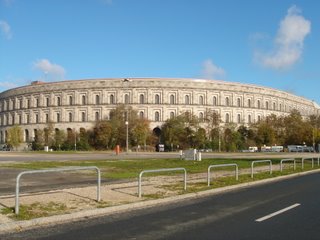
We first came upon a huge round stadium with pillars. It looked like a huge professional sports team's stadium. This is the Kongresshalle (Congress Hall). It is the largest remaining monumental building from the Nazi era. From the outside it looks quite impressive.
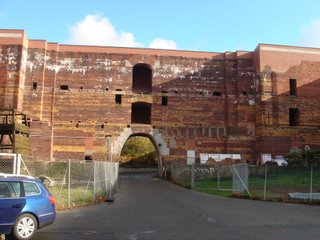
We drove inside (yes, drove inside - that is the back end of our Passat in the picture) and you could see that the inside is basically just a run-down storage center.
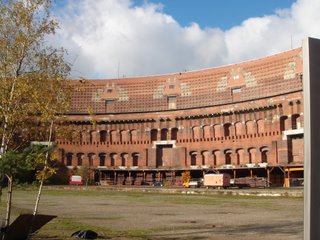
Hitler had plans to build another venue that was even larger. It was to be the Deutsches Stadion and was to have had a seating capacity of 400,000. Only the initial excavation was accomplished. The hole from this excavation filled with ground water and is now the Silbersee. The region also had a large Luitpoldarena for mass SS and SA parades. This area is now a beautiful park with walking/running trails, etc.
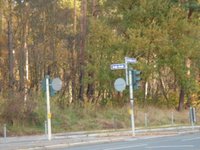

The region also has a huge, wide road called the Grosse Strasse (great road). The road is 60 meters wide! It was used as military exercise grounds and later, after the allies took this region of Germany, the allies used it as a runway for aircraft. Now it is a road - 4 lanes of traffic with parking inbetween. There is a brand new, impressive conference center built to the side.
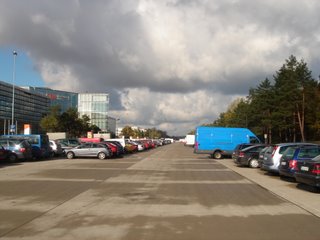

The other structure remaining from the Third Reich is the Zeppelinfeld. You probably will recognize this structure from pictures you have seen in history class (I am including some here to help put this in historical perspective). The Zeppelinfeld is a huge area/outdoor stadium with a large grandstand called the Zeppelintribune. It is the Zeppelintribune that you will probably recognize. The kids are standing in front of what remains of the Zeppelintribune in this picture.
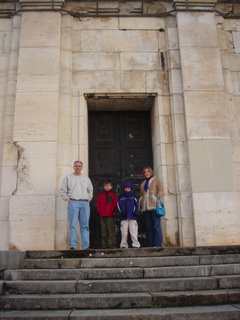
Here are more pictures of the Keppelinfeld from our visit and from the 1930's to get a perspective of what it was like during the Nazi era.

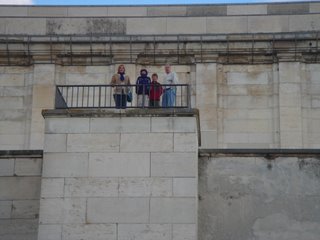
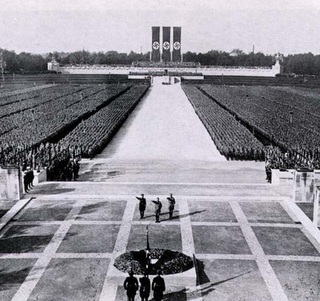
The area seen in the picture just to the right is so large. Now, when you look out over it as we are in the picture above, it houses several soccer fields, parking for large trucks, etc. Here is what this area looks like now from the Zeppelintribune.
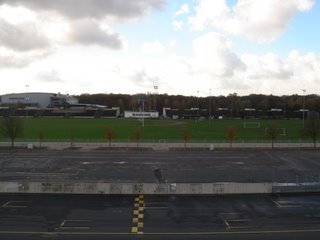
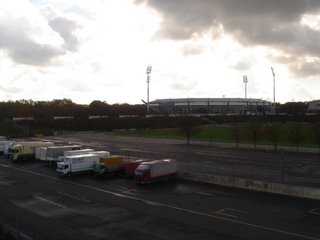
To get some perspective of the size of these grounds, the soccer stadium you see in the photo above is right next to one side of the Zeppelinfeld grounds. It is much smaller than the Zeppelinfeld but was big enough to hold some of the games of the FIFA World Cup this summer.
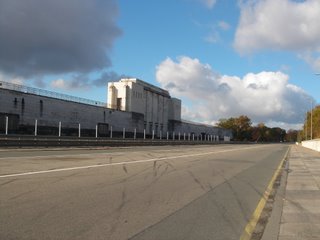
This is the Zeppelintribune from the outside.
From here we drove to the downtown part of Nuremberg. It is an old city. It was an intersection of medieval trade routes, an unofficial capital of the Holy Roman Empire and the city in which many Germany Kings chose to live. It was a center for art and culture. Nuremberg was really destroyed in WWII. In 1945 allied bombs reduced much of the city to nothing more than ruble, killing 6000 people. It is amazing to see how beautifully Nuremberg has been rebuilt in only a few decades.
One thing that Nuremberg is known for is the many fountains scattered about the city. It was cold when we were there so a few were boarded up for the winter but we were able to see many of them - without water because it is winter.
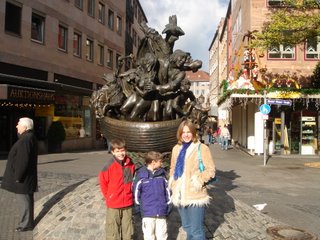
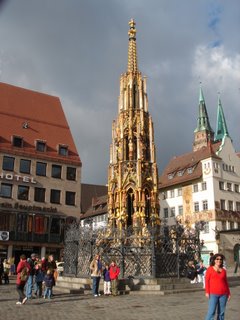
This is the Schoner Brunnen or beautiful fountain and it is really beautiful. It stands in the platz near the Frauen Kirche.
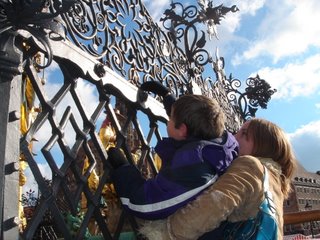
The Schoner Brunnen has a gold ring and superstition says that if you make a wish and turn it three times your wish will come true. Here Daniel is turning the ring. We all took a turn. We'll see how many of our wishes come true!
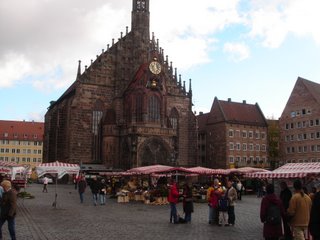
This is the front of the Frauenkirche. There was a market in the platz surrounding the church. We bought some Lebkuchen there - a Nuremberg specialty. They were great!
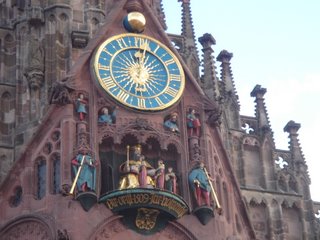
We timed our day to be here, in front of the Frauenkirche, at noon because every day at noon the clock chimes, the doors open, the figures play drums, ring bells, play flutes, trumpets, and seven electoral princes march three times around the seated King Charles IV. As they march by him they turn toward him. It was great fun!
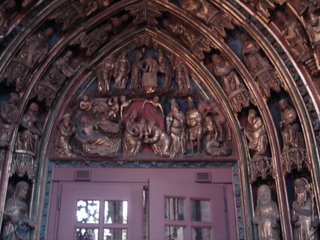
The inside of the Frauenkirche is also beautiful. This is the main doorway/entrance...
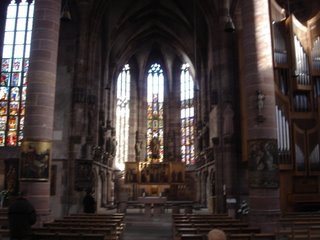
the sanctuary...
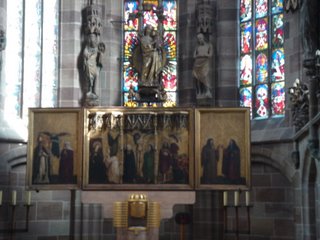
and at the front of the sanctuary is this impressive atler honoring Mary, of course this is the Frauenkirche.
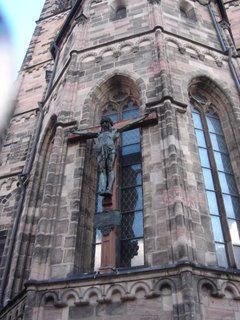
Next, we stopped at St. Sebald's or Sebalduskirche. This was also an impressive, beautiful church with an amazing bronze shrine of St. Sebald near the front.
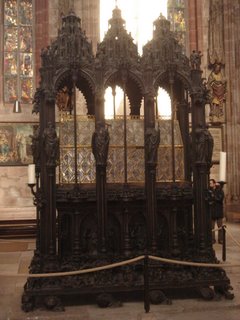
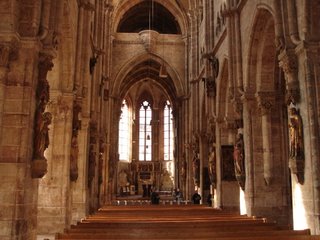
St. Sebald's is the oldest church in Nuremberg. It was reduced to almost nothing in WWII but as you can see was rebuilt to its original splendor. Interestingly, Nuremberg had a moisture-proof Kunstbunker (art bunker) which was used to protect key pieces of art during WWII. So, when it was time to rebuild the most important pieces of art were undamaged.
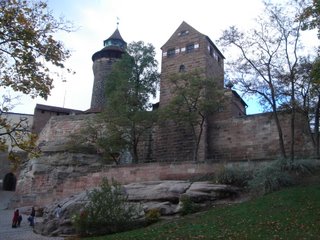
The Kaiserburg (Imperial Castle) was fun to explore. It is a large complex which includes the Kaiser's living quarters, a chapel, a tower called the Sinwellturm and Halls for Knights and other members of the court.
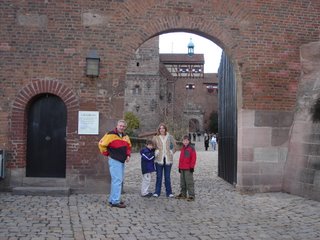
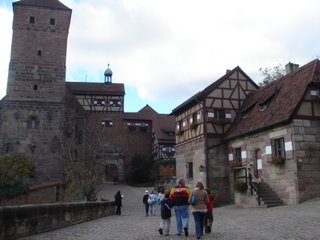
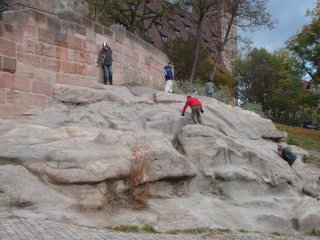
Much of the Kaiserburg was built from natural sandstone. This portion of sandstone is used by kids as a climbing berg - Daniel and Joseph ran off some energy here too!
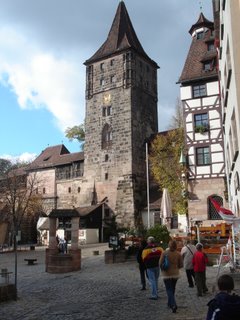
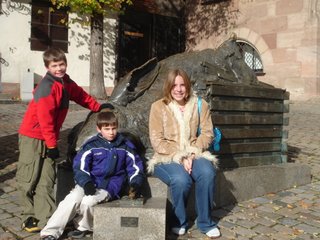
This sculpture, which we found a little creepy, is Der Hase - Hommage a Durer (The Hare - Tribute to Durer). It was inspired by Durer's watercolor from 1502 called Junger Feldhase.
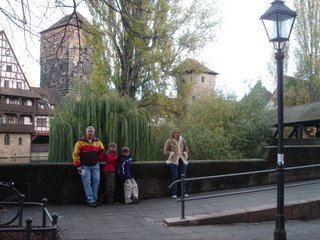
The Pegnitz River flows through Nuremberg. Along and across the river you find beautiful old houses and buildings, walkways and bridges, some of them old covered bridges.
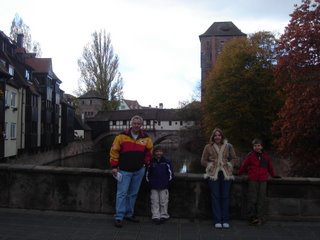
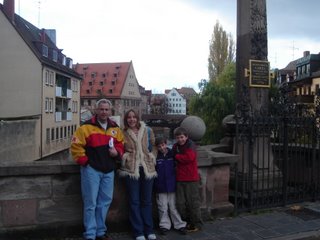
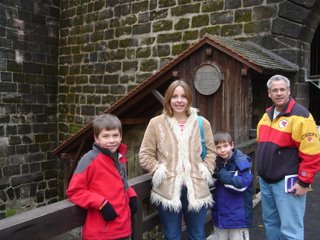
Probable the most famous of Nuremberg's fountains is the Ehekarussell Brunnen. It is a large, metal fountain showing six interpretations of marriage taken from the verse written by Hans Sachs who was a medieval cobbler/poet born in Nuremberg. Jeff and I were able to relate to the stages/interpretations of marriage - perhaps you can too !! :)
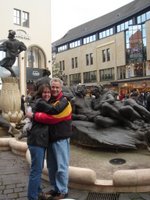
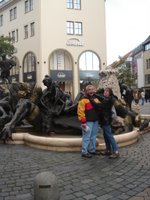
The next stop was the impressive Lorenzkirche or Church of St. Lawrence. This church is full of amazing sculptures, frescos, stained glass. It too was mostly destroyed in WWII but its art treasures were safely stored in the Kunstbunker so we can enjoy them still today.
The Nuremberg riverfront is beautiful!
No trip to Nuremberg is complete without eating Nurembergerwurst. These are small sausages 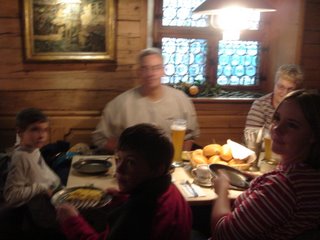 that are quite mild and are served with a nice strong mustard. A plate comes with potato salad or kraut. They were wonderful and were nice and warm on a cold day. Another interesting thing about dining out in Germany - if there are free chairs at an occupied table people will be seated there - joining your table - if the restaurant is full or not. This is a little hard for me to get used to but is nice in a way and you can meet some really interesting people that way. You can see in this picture that we joined a table with two others - really nice Germans who were visiting Nuremberg for the weekend.
that are quite mild and are served with a nice strong mustard. A plate comes with potato salad or kraut. They were wonderful and were nice and warm on a cold day. Another interesting thing about dining out in Germany - if there are free chairs at an occupied table people will be seated there - joining your table - if the restaurant is full or not. This is a little hard for me to get used to but is nice in a way and you can meet some really interesting people that way. You can see in this picture that we joined a table with two others - really nice Germans who were visiting Nuremberg for the weekend.
The Lorenzplatz with the Lorenzkirche at night... (notice the beautiful full moon!).
Of course, it is difficult to think about Nuremberg without thinking about the Nuremberg trials.
On Friday afternoon we stopped at the courthouse where the famous Nuremberg trials were held, convicting and sentencing 22 Nazi leaders in 1945-6. The complex is still a functioning courthouse and Courtroom 600 (Schwurgerrichtssaal 600) is still a functioning courtroom. Therefore, visitors can only visit on the weekends. We returned on Saturday afternoon to see the courtroom made famous in 1945-6.
Here the kids are standing in front of the door that leads up the stairs to Courtroom 600.
The building complex is huge. It was chosen to hold the first war crimes trials in 1945 for a number of reasons. The US and Russia found Nuremberg more "common ground" than Berlin or London as the cold war had already started to rear its ugly head. Nuremberg was symbolic since it was a city in which many Nazi rallies were held. Although Nuremberg was largely destroyed by Allied bombing, this complex was pretty much undamaged (it sits at the edge of the city). Finally, it has an excellent security system. A large jail was just behind these buildings, the buildings were connected by walkways (you can see one of these in the picture below) and these buildings were/are connected to the jail via a system of underground tunnels.
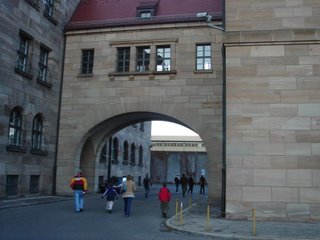
Here you can see one of the connecting walkways. This one connects the large complex (above) with the building that houses Courtroom 600.
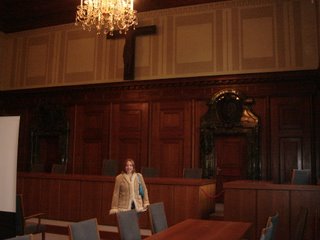
The inside of the courtroom is recognizable from photos of the 1945-6 trials but it is not exactly the same as it was. In 1945 it was changed to accommodate the large number of people, the press, the need for extra security (bullet-proof glass). After the trials were over there was little interest in this room and it was later remodeled to what it was before the Nuremberg trials. It remains like this today and is a working courtroom. I have included a photo from the 1945-6 trials so you can see that it is largely, but not completely identical to what it was then.
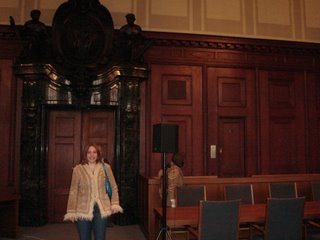
The large doorway behind Ellen can just be seen in the lefthand side of the picture from the trials below. The accused sat to the left of this door (the righthand side of the picture) and behind this area you can just make out a small door. Through this door is an elevator that takes the defendants to the tunnel system that leads, underground, to the jail. It was a secure way to transport those accused in the Nuremberg trials and is still used today.
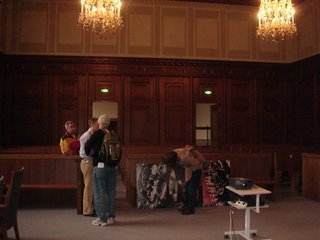
Compare the photos above from our visit to the photo from the Nuremberg Trials (below) and I think you can see that Courtroom 600 is still recognizable as the one from 1945/6.
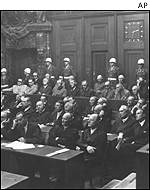
It was really interesting that the weekend we visited Courtroom 600, the location of the first international trial for War Crimes, Saddam Hussein was convicted and sentenced to death by hanging!
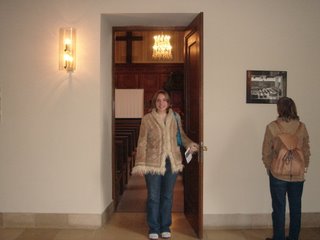
Here Ellen is standing in the doorway into Courtroom 600 as it is today and as it was prior to 1945. This wall was essentially removed to expand the courtroom for the Nuremberg Trials, then later it was remodeled to its pre-1945, original design.
As you can see Nuremberg is a beautiful, fascinating city. We loved our visit and learned a lot!
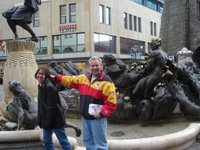
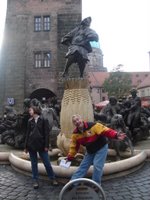
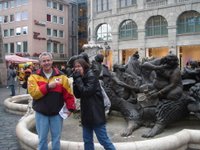
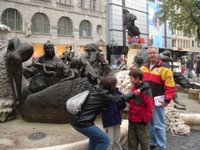

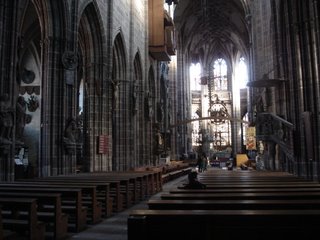
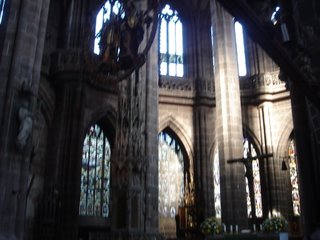


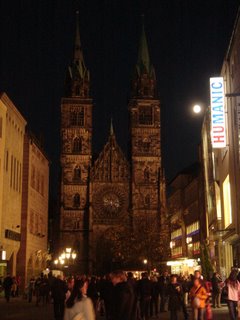
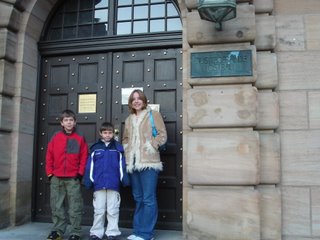
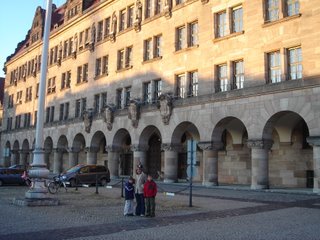
0 Comments:
Post a Comment
<< Home